
94% of researchers rate our articles as excellent or good
Learn more about the work of our research integrity team to safeguard the quality of each article we publish.
Find out more
SYSTEMATIC REVIEW article
Front. Sustain. Food Syst., 28 October 2022
Sec. Social Movements, Institutions and Governance
Volume 6 - 2022 | https://doi.org/10.3389/fsufs.2022.852178
This article is part of the Research TopicWork in Agriculture: New PerspectivesView all 9 articles
Value chains are an important driver for the current labor dynamics in the agri-food sector, and agri-food value chain sustainability strongly depends on decent work conditions. An increasing literature body have been investigated the interactions between chain agents and how it impacted labor issues. Our aim was to map the scientific landscape of the scientific knowledge on labor in agri-food value chains. We performed a bibliometric review of 343 articles indexed in the Web of Science based on descriptive and network analysis of articles metadata, which covered authors, journals, citation times, keywords and countries. We showed that labor in agri-food value chains has an international audience, despite that knowledge production was largely built by a restraint leading scientific network. Overall, the scientific knowledge is organized into four main research domains on labor in agri-food value chains: (1) labor governance in global value chains through standards, (2) employment in value chains and impacts on socioeconomic conditions of rural areas, (3) gender issues and value chains, (4) labor and upgrading in global value chains. The controversies in the international literature regarding labor issues in the agri-food value chains, and blind spots of current research are discussed.
Global agri-food trade grows 3.8% per year since 1990 and reached a value of USD 1.37 trillion in 2019 (Poonyth, 2021). This important economic activity have been connecting agricultural production and food consumption in different countries through the agri-food value chains, which we understand as “the full range of farms and firms and their successive coordinated value-adding activities that produce particular raw agricultural materials and transform them into particular food products that are sold to final consumers and disposed of after use” (Kaplinsky and Morris, 2000; FAO, 2014).
The performance of these coordinated activities requires labor force and create employment opportunities across the value chain (FAO, 2014; OECD, 2021), considering that agriculture is a labor-intensive sector, and agri-food value chain is a major employer (Christiaensen et al., 2020; OECD, 2021).
On the one hand, value chains are important drivers for current rural labor dynamics, such as the increasing use of contracting labor to outsource tasks in farms (Barrientos, 2013; Zhang et al., 2017; Forget et al., 2019), the inclusion of rural youth in agri-food employment positions (OECD, 2021), and the movement of farm workforce to food processing and services in low and middle income countries (Christiaensen et al., 2020). On the other hand, agri-food value chain sustainability strongly rely on decent work conditions, such as creation of employment opportunities and high-quality jobs, increasing wages and income, supporting labor productivity, providing safety working conditions, and complying with workers' rights (FAO, 2014).
In this sense, we understand that agri-food value chain agents address labor issues to manage decent work conditions through mechanisms of chain coordination and governance. In global value chains, agents located in different countries depend on different labor regulations, which reinforce the importance of mechanisms of coordination. These mechanisms work through the dyadic interaction between upstream and downstream agents, which are both impacting and being impacted by labor issues.
Therefore, in value chain approach, labor is not considered just as a resource required to bring a product from production to consumption, nor an outcome of agri-food activities, which is the case of other approaches (i.e., supply chain and food system). Instead, labor is considered in a broader way, as observed in several agri-food value chain studies performed in diverse circumstances across the world. In order to illustrate that, we can highlight some examples from the literature: the case of employment conditions of hired workers in production and processing plants in the horticultural global value chain connecting Kenyan large-farms and packhouses (upstream) to United Kingdom retailers (downstream) (Dolan, 2004); the map of the gendered division of labor covering all stages between production in smallholder farms and consumption in local market in the cassava value chain in Tanzania (Masamha et al., 2018); the working conditions of farmers and hired workers in production and processing in coffee value chain connecting farmers, cooperatives and exporters in Nicaragua to international importers (Valkila and Nygren, 2010); and labor rights of boat crew in the fish value chain linking South Korean fishers to New Zealand firms (Stringer et al., 2014).
Labor governance was identified in a recent bibliometric review as an emergent topic linking the international literature between work in agriculture and value chains, but not deepened (Malanski et al., 2021a). Despite the increasing literature body using the value chain approach to investigate the interactions between chain agents and how they are impacted by labor, there are no studies summarizing the advances of value chains approaches related to the broad scope of labor studies in agri-food value chains. Our aim is to map the landscape of the scientific knowledge on labor in agri-food value chains through a bibliometric review in the Web of Science.
In the next session we describe the methodology design that allowed us to characterize the international scientific landscape and identify the main research domains related to labor in agri-food value chains. The controversies in the international literature regarding labor issues in the agri-food value chains, and blind spots of current research are discussed.
We performed the bibliometric analysis according to the PRISMA guidelines for reviews (Preferred Reporting Items for Systematic Reviews and Meta-Analyses) (Moher et al., 2009; Figure 1).
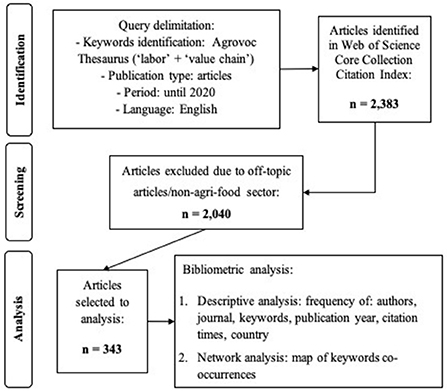
Figure 1. Methodological design of the bibliometric analysis structured in three main steps: (1) identification of articles; (2) screening to exclude off-topic articles; (3) final selection of articles and analysis. Adapted from Moher et al. (2009).
We used the Web of Science Core Collection Citation Index to identify the articles and build our database. First of all, we build the query to identify the articles. The keywords were identified through Thesaurus Agrovoc from FAO to standardize the terms and obtain greater accuracy in the search, resulting in the identification of relevant articles for our topic. Regarding “labor,” the similar terms identified were: “work,” “job,” “employment,” and “occupation.” Regarding “value chain,” we remained with the same term, as it encompasses global value chains. All time available was considered (from 1945 to 2020) in order to have an overview of the theme. Articles in English were selected in order to analyze international publications. Therefore, we not included in the query secondary papers summarizing or introducing topics, such as reviews and editorials, nor gray literature (i.e., proceedings papers). We used the topic-oriented search (title, abstract, keywords) to identify a greater number of articles than by title-oriented search. Thus, the search on the Web of Science was based in the following query: [TS = (“value chain*”) AND (work* OR labo?r OR job* OR employ* OR occupation*)]. According to those criteria, we identified 2,383 articles.
These articles were then manually screened by reading the title and abstract, and checking whether the articles fit our theme. Off-topic articles related to non-agricultural (e.g., garment) sector or non-food production (e.g., fiber and fuel) were excluded. We finally selected 343 articles published between 2000 and 2020. Then, we performed a normalization of authors' keywords to retain only one keyword between singular and plural (e.g., value chain/value chains), British and American English (e.g., labor/labor), lowercase and uppercase letter (e.g., employment/Employment). Finally, we obtained 934 keywords.
The variables of our database included the metadata of the selected articles: authors, title, journal, keywords, publication year, citation times, and country. When authors' keywords are not indicated in the article, we used the words from the title to fulfill this information in order to maintain the article in our database, since keywords are central in our analysis.
The descriptive analysis was performed using the Web of Science tool “Analyze results,” which is based on the frequency of authors, journals, and countries to identify the main publishers related to labor in agri-food value chains. Results are displayed in a Treemap ranking the number of articles identified in our database by categories in the variable analyzed.
The keyword analysis was performed using the “Network Analysis” tool in the CorText Platform, which is based on keywords co-occurrence frequency. Distributional metrics was calculated using the Louvain algorithm, which is based on hierarchical and iterative detection of communities in a complex network by measuring density within and between communities (Blondel et al., 2008). Results are presented in a network graph composed by nodes represented by triangles (e.g., keywords) whose size indicates frequency. Linkages between keywords are represented by a gray line, and high-frequency co-occurrence of a group of keywords are displayed in a cluster (e.g., colored circle). The results provided an overview of the international scientific production, helping us to identify the main research domains related to labor in agri-food value chains.
Despite value chains approach have been developed since the years 1990, labor in agri-food value chains is a relative new topic discussed by the international scientific community, as the 343 articles identified have been published since 2000 (Figure 2). However, we observed an increasing number of publication overtime. Until 2011, the new topic is launched with few articles published and cited by year. Between 2012 and 2016, the interest of researchers continues to rise, as the number of articles and citations were twice as high as the previous period. Since 2017, the consolidation of the topic is ongoing, considering that the number of articles and citations strongly increased. According to this trend, labor in agri-food value chains is a topic under construction by the international scientific community, with a promising expansion and consolidation in the next years.
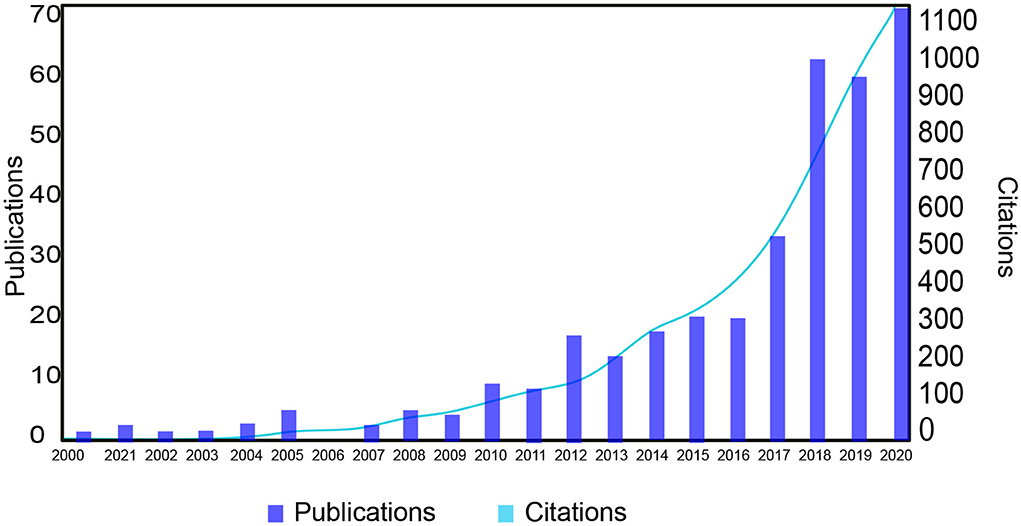
Figure 2. Increasing number of articles published and citations between 2000 and 2020 related to labor in agri-food value chains.
The identified articles included research from 82 countries. The countries that published at least 10 papers between 2000 and 2020 are displayed in Figure 3. England, United States and Germany are the high publishers, since they are responsible for 55% of articles. Kenya, India, South Africa, Ethiopia, and Mexico are among the high publishers, despite developed countries are prevalent.
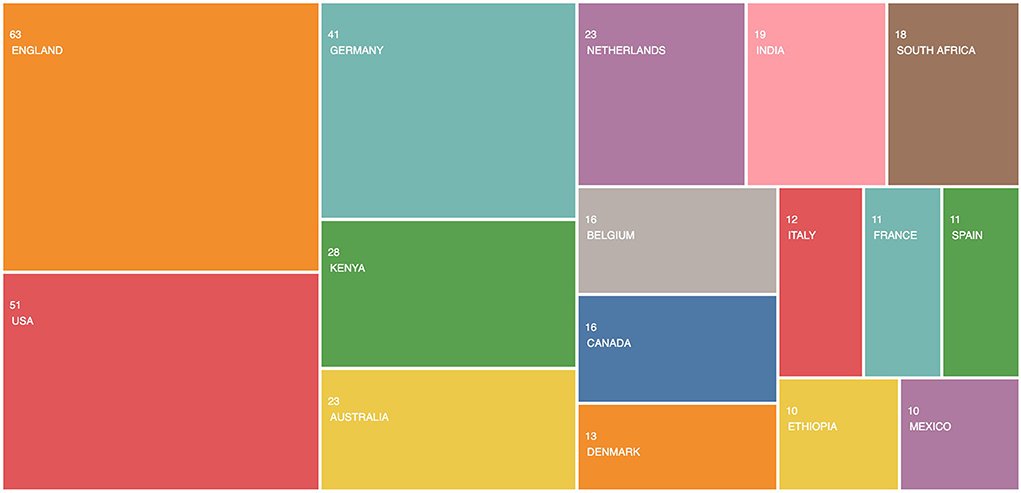
Figure 3. Top countries developing research about labor in agri-food value chains between 2000 and 2020. Number above the country indicate the number of total publications identified in our database.
Almost 200 journals and more than 1,000 authors published about labor in agri-food value chains over the past 21 years, which indicates that this is a theme with a large audience. Regarding the journals, the multidisciplinary or interdisciplinary perspective are prevalent among the high publisher ones, whether they are focused in the upstream (e.g., agricultural production) or downstream (e.g., food) part of the chain. However, 80% of journals published at most two articles between 2000 and 2020 (Figure 4).
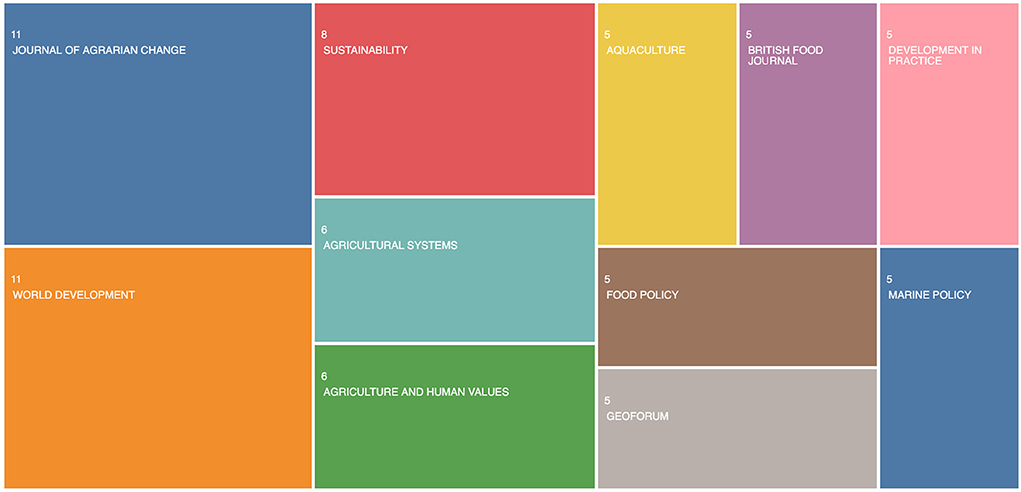
Figure 4. Reference journals publishing about labor in agri-food value chains between 2000 and 2020. Number above journal title indicates the total of publications identified in our database.
Regarding the authors, the high publisher ones are responsible for 18% of overall publications. However, 98% of authors published at most two articles over the past 21 years, which shows a strong punctual and fragmented contributions regarding analysis of labor in agri-food value chains (Figure 5).

Figure 5. Reference authors on labor in agri-food value chains that published at least four articles between 2000 and 2020. Number above author's name indicates the total of publications.
The reference articles are displayed in Table 1, which were mainly published in multidisciplinary journals related to development studies (i.e., World Development, Journal of Development Studies…) or journals related to economics (i.e., Ecological Economics, Annual Review of Resource Economics). Based on keywords, we observed that international community was strongly interested by labor standards and other types of standards (e.g., private standards, private social standards, sustainability, codes of conduct, corporate codes, certification), global value chain governance, and contract labor (Table 1). Four of the reference authors (Barrientos S., Riisgaard L., Tallontire A., Mutersbaugh, T.) had articles among the high cited ones. Moreover, Gereffi G., author of seminal articles for the value chains approach, is co-author in two high cited articles.
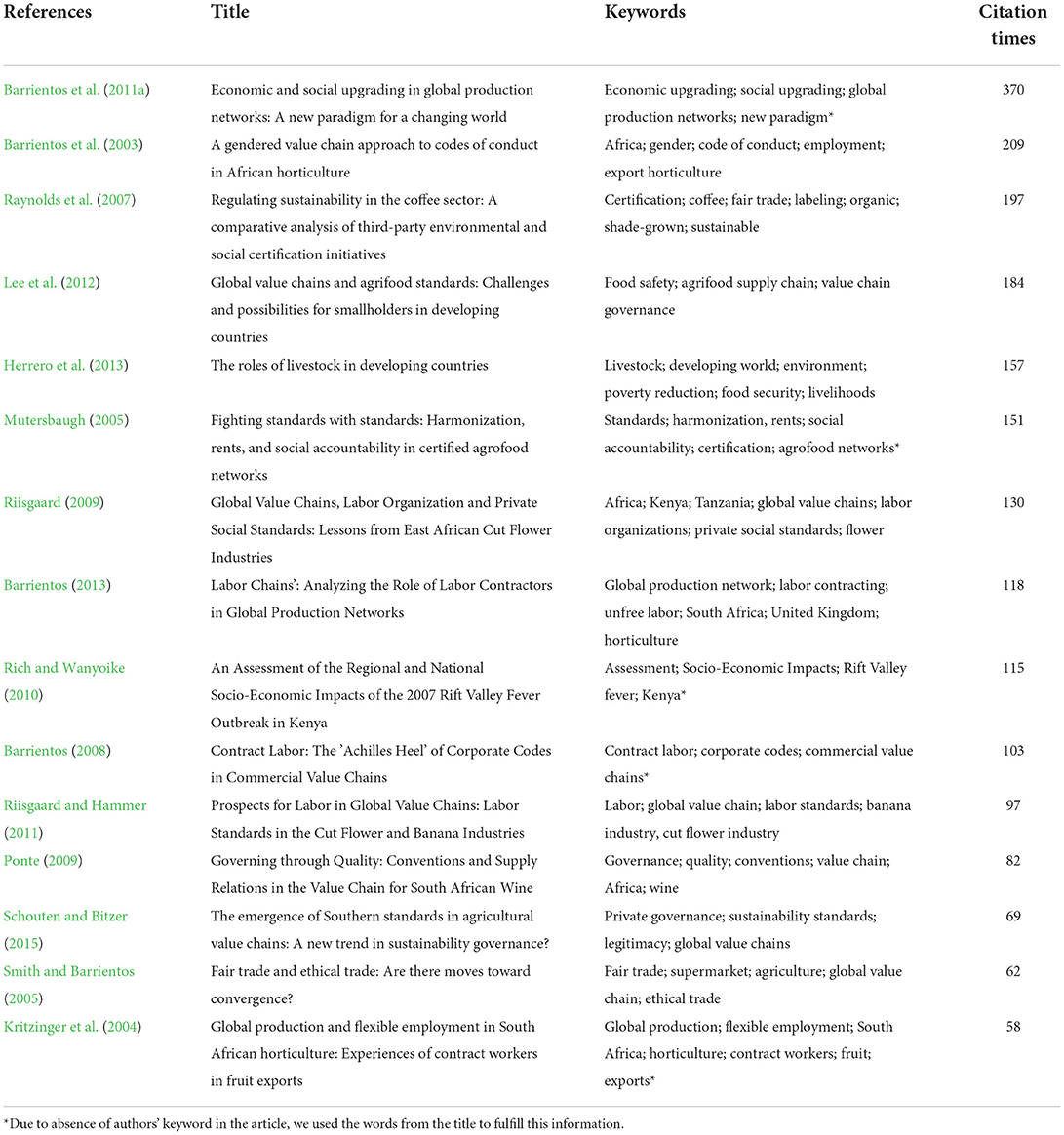
Table 1. Description of the high cited articles related to labor in agri-food value chains published between 2000 and 2020.
The network analysis of keywords allowed us to identify four research domains on labor in agri-food value chains: (1) labor governance in global agri-food value chains through standards, (2) employment in agri-food value chains and impacts on socioeconomic conditions of rural areas, (3) gender issues and agri-food value chains, (4) labor and upgrading in global agri-food value chains (Figure 6).
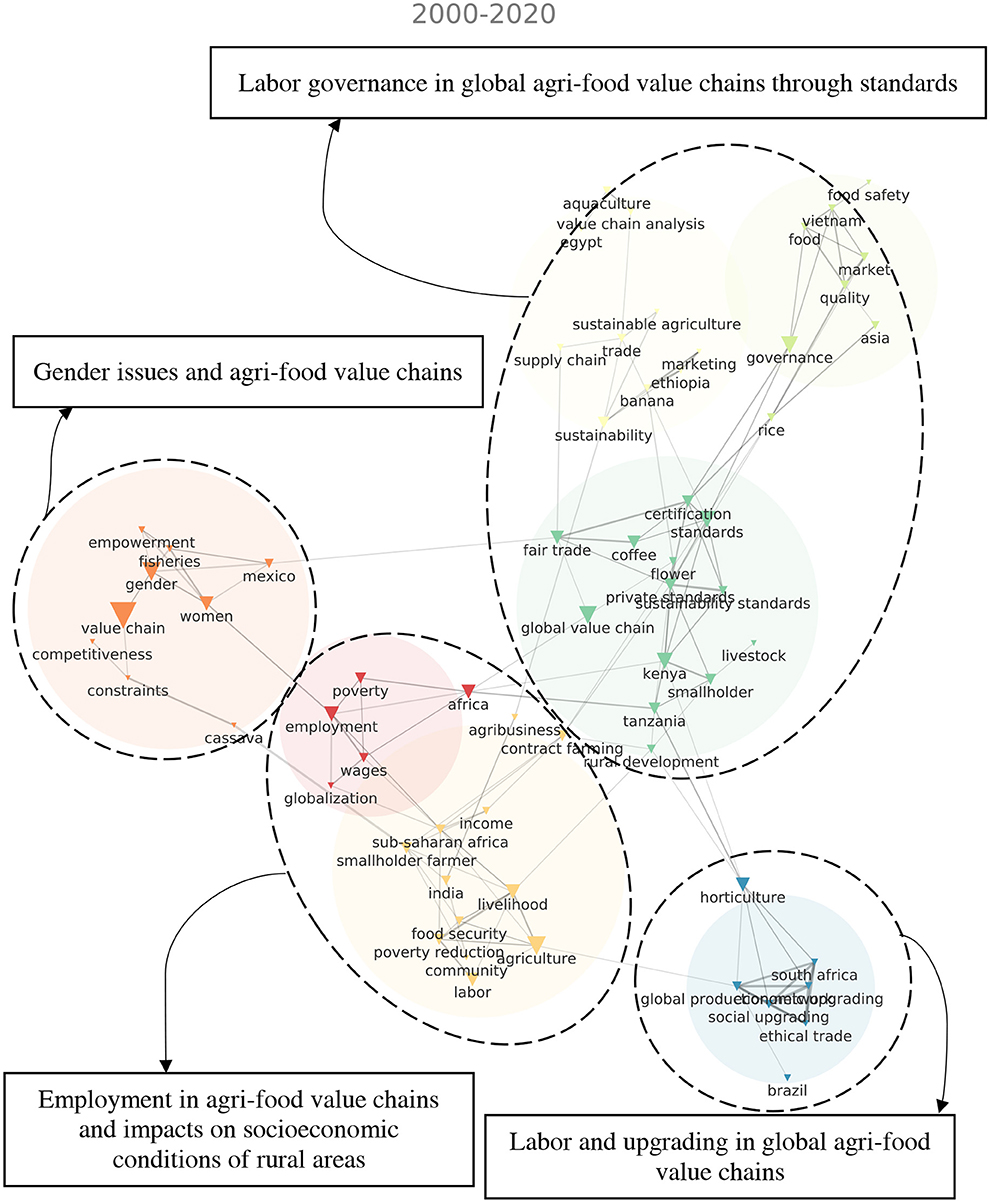
Figure 6. Network map of scientific knowledge on labor in agri-food value chains for the period 2000–2020. Four research domains are identified: (1) labor governance in global agri-food value chains through standards, (2) employment in agri-food value chains and impacts on socioeconomic conditions of rural areas, (3) gender issues and agri-food value chains, (4) labor and upgrading in global agri-food value chains.
Labor governance in global agri-food value chains through standards is the first research domain, which is focused on the analysis of how agri-food value chain agents coordinate labor issues within the chain. Standards are the main mechanism of governance used by the agents, principally private standards—including certification (e.g., fair trade)—to regulate several issues, whether they are directly or indirectly linked to labor, such as sustainability, food quality and safety. The highlighted empirical studies are related to diverse of agri-food value chains (e.g., livestock, flower, coffee, banana, aquaculture) in African countries (e.g., Kenya, Tanzania, Ethiopia, Egypt), and rice value chain in Asian countries (e.g., Asia, Vietnam). The paper by Raynolds et al. (2007) provide us an example of studies developed in this research domain. The authors compared five third-party certifications and showed their differences on governance structure, including environmental and social standards, and the alignment of social standards to ILO conventions for decent work (e.g., rights to association and collective bargaining, freedom from discrimination and unequal pay, no forced or child labor, minimum social and labor conditions, rights to safe and healthy working conditions) (Raynolds et al., 2007).
The second research domain, “employment in agri-food value chains and impacts on socioeconomic conditions of rural areas,” is related to the socioeconomic impacts of agri-food value chain development in rural areas. It is focused on to two connected factors. The first factor is employment creation and income generation (e.g., employment, wages, income) due to the inclusion of smallholder farmers in global markets, including contracting farming. The second factor is the impacts of employment creation and income generation on broader socioeconomic conditions of rural areas, which cover poverty reduction, livelihood food security, and rural development. For example, Rich and Wanyoike (2010) assessed the multi-dimensional socioeconomic impacts of the 2007 Rift Valley Fever Outbreak in livestock value chains in Kenya, which included employment and income reduction, food insecurity among producers, and economic losses throughout the value chain (Rich and Wanyoike, 2010).
Gender issues and agri-food value chains is the third research domain. A gendered analysis throughout the value is focused on the women labor—but not limited to-, the benefits to be included in agri-food value chains (e.g., empowerment), and constraint to keep competitive in chains. Regarding the fish value chains, Murphy et al. (2020) identified the gender-based market constraints and their impact on retailers enterprise economic performances (Murphy et al., 2020).
The fourth research domain is labor and upgrading in global agri-food value chains. Upgrading is understood as the path to higher value-added activities aiming to improve profits, technology, knowledge and skills. The economic upgrading regards improvements in processes, product, and technology, which impact value chain efficiency. The social upgrading regards improvement in the rights, employment conditions and benefits for workers. Based on examples from agri-food sector and non-agricultural sectors (garment, information technology), Barrientos et al. (2011a) showed how the relationship between economic and social upgrading address decent work issues while increasing the value added Barrientos et al. (2011b).
An increasing literature body is using the value chain approach to investigate how interactions between upstream and downstream chain agents are impacting and being impacted by labor issues in the agri-food sector, such as power relations for the compliance with fundamental labor rights in banana plantations and workers collective bargain (Riisgaard, 2005), or the adoption of fair trade certification to demonstrate the adoption of social standards along the chain (Raynolds et al., 2007; Valkila and Nygren, 2010). We showed that labor in agri-food value chains has international audience, and the consolidation of this new scientific community is in progress. However, knowledge production in this field must become consistent overtime. This condition implies in a radical change of the current pattern, which is characterized by mainly advances of a restraint leading scientific network and irregular contributions of several authors around the world.
The lead scientific network is composed mainly by developed countries publishing about labor in agri-food value chains, principally England, USA, Germany. However, we identified that developing countries are included among the main producers of scientific knowledge in this field, especially Kenya, India, and South Africa. The highlighted contributions from developed and developing countries are a specificity of the value chains scientific community, and previous reviews regarding labor studies in agriculture showed that Africa, Asia and Latin America are data-providing regions (Oliveira et al., 2017; Malanski et al., 2019, 2021b). This could be linked to the increasing participation of developing countries in the global agri-food trade (Poonyth, 2021), which provides a diversified empirical conditions for research, since countries have different socioeconomic and institutional conditions for the expansion of the agri-food activities and trade.
This scenario was the basis to the development of four main research domains on labor in agri-food value chains: (1) labor governance in global value chains through standards, (2) employment in value chains and impacts on socioeconomic conditions of rural areas, (3) gender issues and value chains, (4) labor and upgrading in global value chains (Figure 6). Among them, labor governance is the biggest. Governance is a major topic in the value chain approach, since the coordination of chain agents is essential to ensure that activities within the value chain works (Humphrey and Schmitz, 2001; Gereffi et al., 2005). Governance in an agri-food value chain is headed by a key agent that coordinates other chain agents. Considering that agri-food chain is a buyer-driven value chain (Kaplinsky and Morris, 2000), retailers are identified as key agents in global agri-food trade (Freidberg, 2003; Dolan, 2004; Kritzinger et al., 2004; Lee et al., 2012).
However, the literature also highlights the important role of international bodies in value chain governance, which is the case of ILO and FAO, with advanced decent work guidelines in global trade (Barrientos et al., 2011b; FAO, 2014; Posthuma and Rossi, 2017). Decent work guidelines were largely assimilated in standards regulating labor issues in agri-food value chains (Barrientos et al., 2003; Raynolds et al., 2007; Grammont and Flores, 2010; Valkila and Nygren, 2010; Riisgaard and Hammer, 2011; Ahsan et al., 2018). In addition, non-governmental organizations and civil society are pressuring chain agents against employment pre-carity and poor working conditions (Riisgaard, 2005; Brown and Getz, 2008; Piao et al., 2019). Consumers awareness about these labor issues is rising and they are more attentive to standards (e.g., certifications, labels) when purchasing an agricultural product (Janssen and Hamm, 2012; Grunert et al., 2014; Liu et al., 2019).
Nevertheless, the effectiveness of the standards as mechanisms to improve employment and working conditions is not a consensus in the international literature (Barrientos et al., 2003; Barrientos, 2008; Riisgaard, 2009; Grammont and Flores, 2010; Valkila and Nygren, 2010; Riisgaard and Hammer, 2011; Lee et al., 2012; Pegler, 2015; Ahsan et al., 2018). This situation sheds some light in the contradictions about the upgrading capacity of agri-food value chains. Both economic and social upgrading of agents within a value chain are main arguments to support the development of value chains, especially considering the benefits for upstream agents in developing countries (Barrientos et al., 2011a; Trienekens, 2011). On the one hand, the literature from the perspective of downstream agents highlights that the development of value-adding activities improves technology, profits and knowledge for upstream agents, the creation of employment is associated to the demand for higher skilled workers as a consequence (Carr et al., 2000; Barrientos et al., 2011a,b). That literature more focused in economics considered labor as a resource, thus labor costs where the main issue when discussing the relation between labor and economic upgrading in global trend (Barrientos et al., 2011b). On the other hand, the literature from the perspective of upstream agents highlights that inclusion in value chains do not necessarily improves employment and working conditions (Barrientos et al., 2011a,b). The literature more focused in socioeconomics considered labor under several aspects when discussing labor and social upgrading, as worker's rights, decent work, labor regulation, employment and working conditions (Dolan, 2004; Riisgaard, 2005; Pegler, 2015; Staelens et al., 2018; Matheis and Herzig, 2019). Such contradictions between economic and social upgrading of agri-food value chains regarding labor issues are related to the development of flexible and precarious employment and work (Barrientos et al., 2011b), principally for the most socioeconomic vulnerable people (e.g., women and migrants) in the upstream part of the value chain (Barrientos et al., 2003, 2019; Dolan, 2004; Tallontire et al., 2005; Grammont and Flores, 2010; Milbourne and Coulson, 2021).
The development of agri-food value chains in rural territories impacts socioeconomic conditions of people. However, the nature of impacts is controversial. As we indicated above, lack of decent work is a central concern, which negatively affects the sustainable development of agri-food value chains (FAO, 2014). While some authors argue that agri-food value chains plays a key role in promoting regional development through integration of farms in markets and stimulating value-adding activities in food transformation and marketing (Lie et al., 2012; Maertens et al., 2012; Hardesty et al., 2014; Christiaensen et al., 2020). Increasing income and decreasing food insecurity in poor households, as well as poverty reduction in rural areas through employment creation and farmers market inclusion are the main benefits indicated by authors (Lie et al., 2012; Maertens et al., 2012). These arguments are even more highlighted when considering that 75% of poorest people in the world live in rural areas (FAO, 2018).
Women are among the most vulnerable socioeconomic workers in agri-food sector (Tallontire et al., 2005; Barrientos et al., 2019). Some authors indicated that women inclusion in agri-food value chains contribute to decrease the gender gap and increase women empowerment through several actions (e.g., equal payment for men and women, maternity rights, female specific training, family-friendly policies), which can rely on the adoption and the compliance with gendered labor standards (Barrientos et al., 2019; Raynolds, 2021). Despite the advances, gender inequalities remain as a major concern for sustainable agri-food value chain, such as institutional barriers to active voice of women in cooperatives (Wijers, 2019), strong concentration of male workers in packaging, transportation and marketing (Masamha et al., 2018; Murphy et al., 2020), unequal decision-making power in households (Oduol et al., 2017; Bullock et al., 2018; Masamha et al., 2018), difficulties to access production assets (Deere and Leon, 2003; Doss, 2018; Kang et al., 2020).
The main labor issues are addressed by value chains agents though standards, principally labor standards (Riisgaard and Hammer, 2011), or those associate with social standards (Raynolds et al., 2007; Riisgaard, 2009), and certifications regulating broad sustainable parameters, which includes the social ones (e.g., fair trade) (Raynolds et al., 2007; Valkila and Nygren, 2010). Those standards are strongly linked to decent work guidelines defined by international bodies, such as ILO and FAO (Raynolds et al., 2007; Riisgaard and Hammer, 2011; FAO, 2014), and several field work showed their impacts on employment conditions, income generation and wages, working conditions, safety work, and gendered issues (Barrientos et al., 2003; Dolan, 2004; Grammont and Flores, 2010; Valkila and Nygren, 2010; Ahsan et al., 2018; Masamha et al., 2018; Murphy et al., 2020). Despite the advances in the value chain literature body covering the broad socioeconomical impacts of regulation of labor issues trough social standards, we identified some critical blind spots regarding the governance of labor in agri-food value chains.
We understand that standards for agricultural production and processing, food quality and food safety also impact labor, and these impacts are not necessarily addressed by labor or social standards. For example, UK retailers requirement regarding food quality and flexible supply (i.e., according to demand) resulted in long working days varying between 8 and 16 h per day in 6 days a week in large horticultural farms in Kenya (Dolan, 2004). USA retailers or processing plants requirements regarding food quality and food safety resulted in changes in agronomic practices and buildings to produce tomato all year-round and changed work pattern from seasonal to “permanent year-round” in large and very large farms in Mexico (Grammont and Flores, 2010). Multinational export enterprise's requirements for high-quality mango are better achieved by smallholder farmers in Costa Rica when labor is performed by family workers than employees (Zúñiga-Arias et al., 2008). Therefore, these mechanisms of labor governance in agri-food value chains have implications on issues like new tasks to perform due to changes in agronomic practices, rhythms to perform tasks—whether within a working day or over the year, and work organization though delegation of “critical” tasks to employees.
Another blind spot is how the compliance with standards are impacting the insertion of upstream agents in market, and its consequences for value chain. For example, the application of European Union standards for milk quality in Bulgarian dairy sector resulted in: (1) an outflow of 55% dairy farms supplying dairy industry for EU market due to aging of the household, health problems and an increase in off-farm employment, and (2) the structuration of dairy companies processing milk for domestic market or for export outside EU, as they not complied with EU standards (Van Herck and Swinnen, 2015).
Considering that labor in agri-food value chains is a new scientific community, we intended to identify some blind spots, rather to cover all of them. Moreover, other research topics can emerge overtime according to interactions between upstream and downstream agents, local and global labor dynamics, public and private governance of labor, food production and processing, and consumers' demands. A suggestion for future research is to build a typology based on a detailed analysis of topic diversity, including disciplines, approaches, methods in each one.
We provided a map of the scientific knowledge on labor in agri-food value chains through a bibliometric review. The rise of this new scientific community is based on seminal contributions of a leading scientific network that nurture the strong development of research for an international audience over the past 21 years. Their main contributions are organized into four main research domains on labor in agri-food value chains: (1) labor governance in global value chains through standards, (2) employment in value chains and impacts on socioeconomic conditions of rural areas, (3) gender issues and value chains, (4) labor and upgrading in global value chains.
Although, behind these common research domains, the international literature indicates important controversies regarding labor issues in the agri-food value chains, such as the effectiveness of the standards (e.g., certifications) as mechanisms to regulate labor issues, the capacity of agri-food value chains to couple with economic and social upgrading and enhance employment and working conditions, including gender gap, and the socioeconomic impacts in rural territories due to the development of agri-food value chains. These controversies strongly invite researchers to invest in empirical studies to identify their drivers, dynamics, and patterns. In this sense, we also identified some blind spots of current research, principally the neglected effect of standards for agricultural production and processing, food quality and food safety on labor issues in agri-food value chains.
Further research could bring valuable information for chains agents to improve labor governance according to ILO and FAO decent work guidelines, and, thus, enhance sustainable agri-food value chain development.
The raw data supporting the conclusions of this article will be made available by the authors, without undue reservation.
PM analyzed data and wrote the first manuscript draft. PM, SS, BD, and JD designed research, discussed the results, and contributed to the final manuscript. All authors contributed to the article and approved the submitted version.
We gratefully acknowledge the CAPES—Brazil for funding (Grant No. 88882.463223/2019-01).
The authors thank members of the International Association on Work in Agriculture for their support and suggestions.
The authors declare that the research was conducted in the absence of any commercial or financial relationships that could be construed as a potential conflict of interest.
All claims expressed in this article are solely those of the authors and do not necessarily represent those of their affiliated organizations, or those of the publisher, the editors and the reviewers. Any product that may be evaluated in this article, or claim that may be made by its manufacturer, is not guaranteed or endorsed by the publisher.
Ahsan, M. B., Mehdi, M., Ahmad, B., and Ahmad, U. S. (2018). Understanding the interdependence between worker livelihoods and decent work at certified and non-certified mango orchards in Pakistan. Earth Syst. Environ. 2, 621–632. doi: 10.1007/s41748-018-0075-5
Barrientos, S. (2008). Contract labour: the ‘achilles heel' of corporate codes in commercial value chains. Dev. Change 39, 977–990. doi: 10.1111/j.1467-7660.2008.00524.x
Barrientos, S., Bianchi, L., and Berman, C. (2019). Gender and governance of global value chains: promoting the rights of women workers. Int. Labour Rev. 158, 729–752. doi: 10.1111/ilr.12150
Barrientos, S., Dolan, C., and Tallontire, A. (2003). A gendered value chain approach to codes of conduct in African horticulture. World Dev. 31, 1511–1526. doi: 10.1016/S0305-750X(03)00110-4
Barrientos, S., Gereffi, G., and Rossi, A. (2011a). Economic and social upgrading in global production networks: a new paradigm for a changing world. Int. Labour Rev. 150, 319–340. doi: 10.1111/j.1564-913X.2011.00119.x
Barrientos, S., Mayer, F., Pickles, J., and Posthuma, A. (2011b). Decent work in global production networks: framing the policy debate. Int. Labour Rev. 150, 299–317. doi: 10.1111/j.1564-913X.2011.00118.x
Barrientos, S. W. (2013). ‘Labour chains': analysing the role of labour contractors in global production networks. J. Dev. Stud. 49, 1058–1071. doi: 10.1080/00220388.2013.780040
Blondel, V. D., Guillaume, J.-L., Lambiotte, R., and Lefebvre, E. (2008). Fast unfolding of communities in large networks. J. Stat. Mech. 10, P10008. doi: 10.1088/1742-5468/2008/10/P10008
Brown, S., and Getz, C. (2008). Privatizing farm worker justice: regulating labor through voluntary certification and labeling. Geoforum 39, 1184–1196. doi: 10.1016/j.geoforum.2007.01.002
Bullock, R., Gyau, A., Mithoefer, D., and Swisher, M. (2018). Contracting and gender equity in Tanzania: using a value chain approach to understand the role of gender in organic spice certification. Renew. Agric. Food Syst. 33, 60–72. doi: 10.1017/S1742170517000151
Carr, M., Chen, M. A., and Tate, J. (2000). Globalization and home-based workers. Fem. Econ. 6, 123–142. doi: 10.1080/135457000750020164
Christiaensen, L., Rutledge, Z., and Taylor, J. E. (2020). Viewpoint: the future of work in agri-food. Food Policy 99, 101963. doi: 10.1016/j.foodpol.2020.101963
Deere, C. D., and Leon, M. (2003). The gender asset gap: land in Latin America. World Dev. 31, 925–947. doi: 10.1016/S0305-750X(03)00046-9
Dolan, C. S. (2004). On farm and packhouse: employment at the bottom of a global value chain. Rural Sociol. 69, 99–126. doi: 10.1526/003601104322919928
Doss, C. R. (2018). Women and agricultural productivity: reframing the issues. Dev. Policy Rev. 36, 35–50. doi: 10.1111/dpr.12243
FAO (2014). Developing Sustainable Food Value Chains: Guiding Principles. Rome: FAO. Available online at: http://www.fao.org/3/a-i3953e.pdf
Forget, V., Depeyrot, J., Mahé, M., Midler, E., Hugonnet, M., Beaujeu, R., et al. (2019). Actif'Agri: Transformations Des Emplois et Des Activités en Agriculture. Paris: Centre d'études et de Prospective, Ministère de L'agriculture et de L'alimentation, la Documentation Française.
Freidberg, S. (2003). Cleaning up down South: Supermarkets, ethical trade and African horticulture. Soc. Cult. Geogr. 4, 27–43. doi: 10.1080/1464936032000049298
Gereffi, G., Humphrey, J., and Sturgeon, T. (2005). The governance of global value chains. Rev. Int. Polit. Econ. 12, 78–104. doi: 10.1080/09692290500049805
Grammont, H. C. D., and Flores, S. M. L. (2010). Productive restructuring and ‘standardization' in Mexican horticulture: consequences for labour. J. Agrar. Change 10, 228–250. doi: 10.1111/j.1471-0366.2009.00246.x
Grunert, K. G., Hieke, S., and Wills, J. (2014). Sustainability labels on food products: consumer motivation, understanding and use. Food Policy 44, 177–189. doi: 10.1016/j.foodpol.2013.12.001
Hardesty, S., Feenstra, G., Visher, D., Lerman, T., Thilmany-McFadden, D., Bauman, A., et al. (2014). Values-Based supply chains: supporting regional food and farms. Econ. Dev. Q. 28, 17–27. doi: 10.1177/0891242413507103
Herrero, M., Grace, D., Njuki, J., Johnson, N., Enahoro, D., Silvestri, S., et al. (2013). The roles of livestock in developing countries. Animal 7, 3–18. doi: 10.1017/S1751731112001954
Humphrey, J., and Schmitz, H. (2001). Governance in global value chains. IDS Bull. 32, 19–29. doi: 10.1111/j.1759-5436.2001.mp32003003.x
Janssen, M., and Hamm, U. (2012). Product labelling in the market for organic food: consumer preferences and willingness-to-pay for different organic certification logos. Food Qual. Prefer. 25, 9–22. doi: 10.1016/j.foodqual.2011.12.004
Kang, M., Schwab, B., and Yu, J. (2020). Gender differences in the relationship between land ownership and managerial rights: implications for intrahousehold farm labor allocation. World Dev. 125, 104669. doi: 10.1016/j.worlddev.2019.104669
Kaplinsky, R., and Morris, M. (2000). A Handbook for Value Chain Research. Brighton: Institute of Development Studies.
Kritzinger, A., Barrientos, S., and Rossouw, H. (2004). Global production and flexible employment in South African horticulture: experiences of contract workers in fruit exports. Sociol. Rural 44, 17–39. doi: 10.1111/j.1467-9523.2004.00259.x
Lee, J., Gereffi, G., and Beauvais, J. (2012). Global value chains and agrifood standards: Challenges and possibilities for smallholders in developing countries. Proc. Natl. Acad. Sci. U.S.A. 109, 12326–12331. doi: 10.1073/pnas.0913714108
Lie, H., Rich, K. M., Kurwijila, L. R., and Jervell, A. M. (2012). Improving smallholder livelihoods through local value chain development: a case study of goat milk yogurt in Tanzania. Int. Food Agribus. Manag. Rev. 15, 55–85. doi: 10.22004/ag.econ.132789
Liu, C.-C., Chen, C.-W., and Chen, H.-S. (2019). Measuring consumer preferences and willingness to pay for coffee certification labels in Taiwan. Sustainability 11, 1297. doi: 10.3390/su11051297
Maertens, M., Minten, B., and Swinnen, J. (2012). Modern food supply chains and development: evidence from horticulture export sectors in Sub-Saharan Africa. Dev. Policy Rev. 30, 473–497. doi: 10.1111/j.1467-7679.2012.00585.x
Malanski, P. D., Dedieu, B., and Schiavi, S. (2021b). Mapping the research domains on work in agriculture. A bibliometric review from scopus database. J. Rural Stud. 81, 305–314. doi: 10.1016/j.jrurstud.2020.10.050
Malanski, P. D., Schiavi, S., and Dedieu, B. (2019). Characteristics of “work in agriculture” scientific communities. A bibliometric review. Agron. Sustain. Dev. 39, 36. doi: 10.1007/s13593-019-0582-2
Malanski, P. D., Schiavi, S. M. A., and Dedieu, B. (2021a). “Mapping the scientific knowledge on work in agriculture,” in 2nd International Symposium Work in Agriculture (Clermont-Ferrand).
Masamha, B., Thebe, V., and Uzokwe, V. N. E. (2018). Mapping cassava food value chains in Tanzania's smallholder farming sector: the implications of intra-household gender dynamics. J. Rural Stud. 58, 82–92. doi: 10.1016/j.jrurstud.2017.12.011
Matheis, T. V., and Herzig, C. (2019). Upgrading products, upgrading work? Interorganizational learning in global food value chains to achieve the Sustainable Development Goals. GAIA Ecol. Perspect. Sci. Soc. 28, 126–134. doi: 10.14512/gaia.28.2.11
Milbourne, P., and Coulson, H. (2021). Migrant labour in the UK's post-Brexit agri-food system: ambiguities, contradictions and precarities. J. Rural Stud. 86, 430–439. doi: 10.1016/j.jrurstud.2021.07.009
Moher, D., Liberati, A., Tetzlaff, J., and Altman, D. (2009). Preferred reporting items for systematic reviews and meta-analyses: the PRISMA statement. BMJ 6, b2535. doi: 10.1136/bmj.b2535
Murphy, S., Arora, D., Kruijssen, F., McDougall, C., and Kantor, P. (2020). Gender-based market constraints to informal fish retailing: evidence from analysis of variance and linear regression. PLoS ONE 15, e0229286. doi: 10.1371/journal.pone.0229286
Mutersbaugh, T. (2005). Fighting standards with standards: harmonization, rents, and social accountability in certified agrofood networks. Environ. Plan. Econ. Space 37, 2033–2051. doi: 10.1068/a37369
Oduol, J. B. A., Mithöfer, D., Place, F., Nang'ole, E., Olwande, J., Kirimi, L., et al. (2017). Women's participation in high value agricultural commodity chains in Kenya: strategies for closing the gender gap. J. Rural Stud. 50, 228–239. doi: 10.1016/j.jrurstud.2017.01.005
OECD (2021). Jobs for Rural Youth: The Role of Local Food Economies. Paris: Organisation for Economic Co-operation and Development. Available online at: https://www.oecd-ilibrary.org/development/jobs-for-rural-youth_692c0ca1-en (accessed December 3, 2021).
Oliveira, C. C., de Moro, A. R. P., Ulbricht, L., Belinelli, M., Souza, G. F. M., de Gabriel, M., et al. (2017). Ergonomic evaluation of workload by milk production – a bibliometric analysis. Ann. Agric. Environ. Med. 24, 376–382. doi: 10.26444/aaem/75505
Pegler, L. (2015). Peasant inclusion in global value chains: economic upgrading but social downgrading in labour processes? J. Peasant Stud. 42, 929–956. doi: 10.1080/03066150.2014.992885
Piao, R. S., Fonseca, L., Carvalho, E., Macchione Saes, M. S., and Florencio de Almeida, L. (2019). The adoption of voluntary sustainability standards (VSS) and value chain upgrading in the Brazilian coffee production context. J. Rural Stud. 71, 13–22. doi: 10.1016/j.jrurstud.2019.09.007
Ponte, S. (2009). Governing through quality: conventions and supply relations in the value chain for South African wine. Sociol. Rural. 49, 236–257. doi: 10.1111/j.1467-9523.2009.00484.x
Poonyth, D. (2021). Changing Patterns of Agrifood Trade: The Rising Importance of Developing Countries. Rome: FAO.
Posthuma, A., and Rossi, A. (2017). Coordinated governance in global value chains: supranational dynamics and the role of the international labour organization. New Polit. Econ. 22, 186–202. doi: 10.1080/13563467.2016.1273342
Raynolds, L. T. (2021). Gender equity, labor rights, and women's empowerment: lessons from fairtrade certification in Ecuador flower plantations. Agric. Hum. Values 38, 657–675. doi: 10.1007/s10460-020-10171-0
Raynolds, L. T., Murray, D., and Heller, A. (2007). Regulating sustainability in the coffee sector: a comparative analysis of third-party environmental and social certification initiatives. Agric. Hum. Values 24, 147–163. doi: 10.1007/s10460-006-9047-8
Rich, K. M., and Wanyoike, F. (2010). an assessment of the regional and national socio-economic impacts of the 2007 rift valley fever outbreak in Kenya. Am. J. Trop. Med. Hyg. 83, 52–57. doi: 10.4269/ajtmh.2010.09-0291
Riisgaard, L. (2005). International framework agreements: a new model for securing workers rights? Ind. Relat. J. Econ. Soc. 44, 707–737. doi: 10.1111/j.1468-232X.2005.00408.x
Riisgaard, L. (2009). Global value chains, labor organization and private social standards: lessons from East African cut flower industries. World Dev. 37, 326–340. doi: 10.1016/j.worlddev.2008.03.003
Riisgaard, L., and Hammer, N. (2011). Prospects for labour in global value chains: labour standards in the cut flower and banana industries. Br. J. Ind. Relat. 49, 168–190. doi: 10.1111/j.1467-8543.2009.00744.x
Schouten, G., and Bitzer, V. (2015). The emergence of Southern standards in agricultural value chains: a new trend in sustainability governance? Ecol. Econ. 120, 175–184. doi: 10.1016/j.ecolecon.2015.10.017
Smith, S., and Barrientos, S. (2005). Fair trade and ethical trade: are there moves towards convergence? Sustain. Dev. 13, 190–198. doi: 10.1002/sd.277
Staelens, L., Desiere, S., Louche, C., and D'Haese, M. (2018). Predicting job satisfaction and workers' intentions to leave at the bottom of the high value agricultural chain: evidence from the Ethiopian cut flower industry. Int. J. Hum. Resour. Manag. 29, 1609–1635. doi: 10.1080/09585192.2016.1253032
Stringer, C., Simmons, G., Coulston, D., and Whittaker, D. H. (2014). Not in New Zealand's waters, surely? Linking labour issues to GPNs. J. Econ. Geogr. 14, 739–758. doi: 10.1093/jeg/lbt027
Tallontire, A., Dolan, C., Smith, S., and Barrientos, S. (2005). Reaching the marginalised? Gender value chains and ethical trade in African horticulture. Dev. Pract. 15, 559–571. doi: 10.1080/09614520500075771
Trienekens, J. H. (2011). Agricultural value chains in developing countries a framework for analysis. Int. Food Agribus. Manag. Rev. 14, 43–68. doi: 10.1017/9789048514991.003
Valkila, J., and Nygren, A. (2010). Impacts of fair trade certification on coffee farmers, cooperatives, and laborers in Nicaragua. Agric. Hum. Values 27, 321–333. doi: 10.1007/s10460-009-9208-7
Van Herck, K., and Swinnen, J. (2015). Small farmers, standards, value chains, and structural change: panel evidence from Bulgaria. Br. Food J. 117, 2435–2464. doi: 10.1108/BFJ-11-2014-0389
Wijers, G. D. M. (2019). Inequality regimes in Indonesian dairy cooperatives: understanding institutional barriers to gender equality. Agric. Hum. Values 36, 167–181. doi: 10.1007/s10460-018-09908-9
Zhang, X., Yang, J., and Thomas, R. (2017). Mechanization outsourcing clusters and division of labor in Chinese agriculture. China Econ. Rev. 43, 184–195. doi: 10.1016/j.chieco.2017.01.012
Keywords: work, agriculture, value chains, governance, standards, gender, food, employment
Citation: Malanski PD, Schiavi SMA, Dedieu B and Damansceno JC (2022) International research on labor in agri-food value chains: A bibliometric review from web of science. Front. Sustain. Food Syst. 6:852178. doi: 10.3389/fsufs.2022.852178
Received: 10 January 2022; Accepted: 30 September 2022;
Published: 28 October 2022.
Edited by:
Flavio Boccia, University of Naples Parthenope, ItalyReviewed by:
Štefan Bojnec, University of Primorska, SloveniaCopyright © 2022 Malanski, Schiavi, Dedieu and Damansceno. This is an open-access article distributed under the terms of the Creative Commons Attribution License (CC BY). The use, distribution or reproduction in other forums is permitted, provided the original author(s) and the copyright owner(s) are credited and that the original publication in this journal is cited, in accordance with accepted academic practice. No use, distribution or reproduction is permitted which does not comply with these terms.
*Correspondence: Priscila Duarte Malanski, cHJpc2NpbGFtYWxhbnNraTJAZ21haWwuY29t
Disclaimer: All claims expressed in this article are solely those of the authors and do not necessarily represent those of their affiliated organizations, or those of the publisher, the editors and the reviewers. Any product that may be evaluated in this article or claim that may be made by its manufacturer is not guaranteed or endorsed by the publisher.
Research integrity at Frontiers

Learn more about the work of our research integrity team to safeguard the quality of each article we publish.